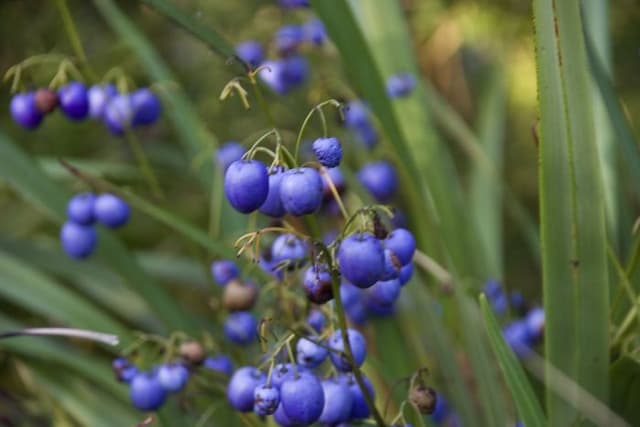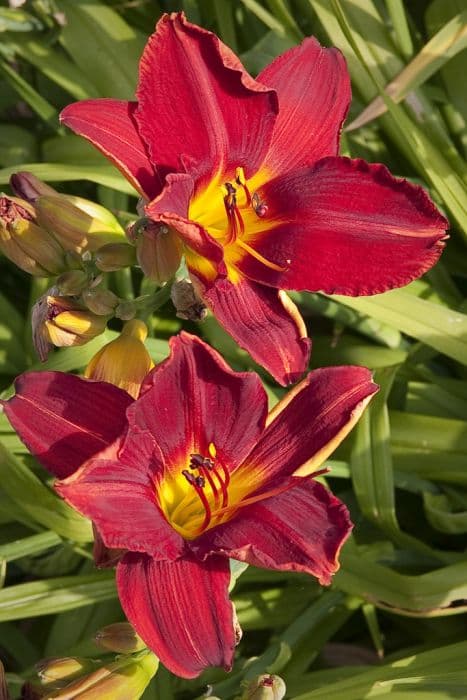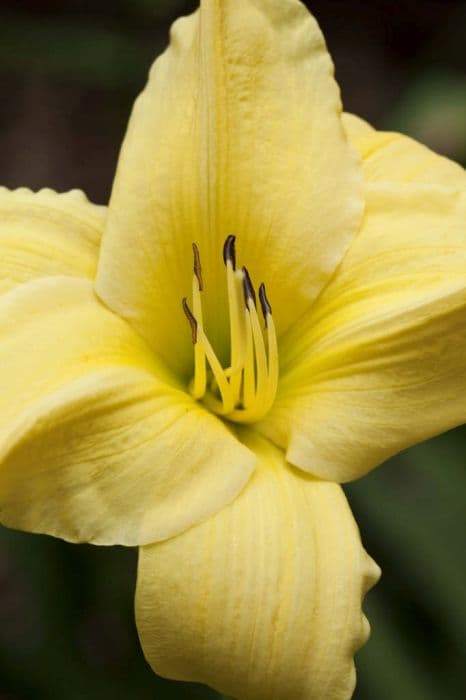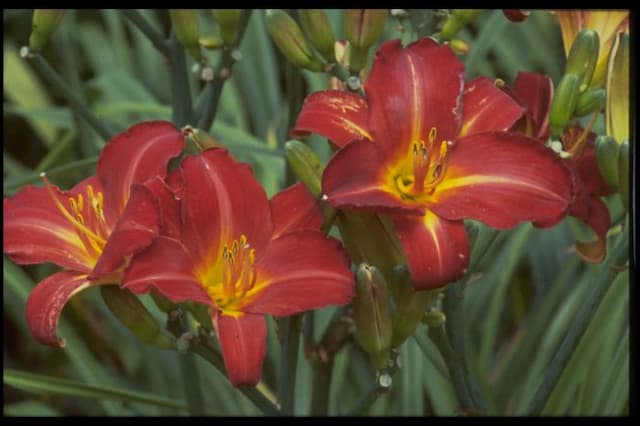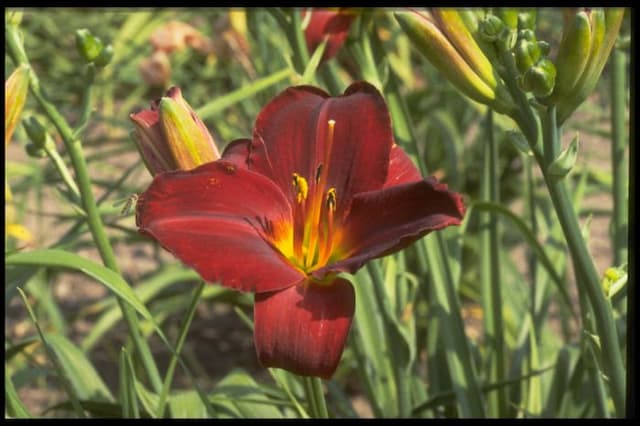Daylily Hemerocallis 'Stafford'

ABOUT
The Hemerocallis 'Stafford', commonly known as the Stafford Daylily, is a perennial plant celebrated for its attractive flowers. The Stafford Daylily boasts blossoms ranging in color from a deep red to a vivid burgundy, often with a contrasting golden or yellow throat that adds a striking dimension to the flower's appearance. Each bloom has a trumpet-like shape with elegantly recurved petals that spread outward, giving the flower a graceful and inviting look. The foliage of the Stafford Daylily is composed of long, slender, arching leaves that are bright green in color. These leaves form a lush clump, providing a verdant backdrop for the display of flowers. The plant typically undergoes a prolific flowering period, where multiple buds emerge on tall, strong stems called scapes. Each scape can carry several buds, which open in succession over weeks, ensuring a long-lasting floral display. This daylily variety is a popular choice for gardens due to its bold flower coloration and its ability to bring visually impactful interest to the landscape. The flowers are not only beautiful to look at but are also able to attract pollinators such as bees and butterflies, making them a beneficial addition to any garden ecosystem. The Hemerocallis 'Stafford' is a hardy plant that is relatively low maintenance, making it suitable for a variety of garden settings and a favorite among garden enthusiasts.
About this plant
 Names
NamesSynonyms
Daylily, Common Daylily, Tawny Daylily.
Common names
Hemerocallis 'Stafford'.
 Toxicity
ToxicityTo humans
Daylily 'Stafford' is not commonly known to be toxic to humans. Indeed, many parts of daylilies are edible and are sometimes used in culinary practices. However, it is important to note that not all individuals may react the same way, and some people might be sensitive or allergic to certain plants, including daylilies. If a person with plant sensitivities ingests daylily parts and experiences symptoms such as nausea, vomiting, or diarrhea, they should seek medical attention. Identification of the specific cultivar is crucial, as there could be confusion with other plants that have similar names but are toxic.
To pets
Daylily 'Stafford' is considered highly toxic to cats and can cause kidney failure. The toxic compound in the plant has not been identified, but ingestion of any part of the plant can lead to symptoms of lethargy, vomiting, appetite loss, kidney failure, and if left untreated, can be fatal. It is critical for cat owners to ensure that their pets do not have access to daylilies. Dogs are not usually affected by daylilies in the same way, but caution is still advised to prevent gastrointestinal upset. If a pet is suspected to have ingested daylily, prompt veterinary attention is necessary.
 Characteristics
CharacteristicsLife cycle
Perennials
Foliage type
Deciduous
Color of leaves
Green
Flower color
Red
Height
2 feet [60 cm]
Spread
2 feet [60 cm]
Plant type
Herb
Hardiness zones
3
Native area
Asia
Benefits
 General Benefits
General Benefits- Easy to Grow: The Stafford Daylily is known for being hardy and low-maintenance, thriving in a range of soil conditions and climates.
- Drought Tolerance: Once established, Stafford Daylilies are drought-tolerant, making them suitable for xeriscaping and water-conservation gardens.
- Long Bloom Season: This variety typically has a long blooming period, offering bright flowers through much of the summer.
- Attracts Pollinators: The vibrant flowers attract butterflies and bees, supporting local ecosystems.
- Landscape Versatility: Stafford Daylilies can be used in a variety of garden styles, from borders to mass plantings.
- Low Pest and Disease Risk: They are generally resistant to many pests and diseases, reducing the need for chemical treatments.
- Erosion Control: The robust root system can help stabilize soil and prevent erosion.
- Edible Parts: Some parts of the daylily, such as the flowers and tubers, are edible for humans, adding a unique element to culinary uses.
- Propagates Easily: Daylilies can be easily divided to propagate new plants and expand garden coverage or share with others.
 Medical Properties
Medical PropertiesThis plant is not used for medical purposes.
 Air-purifying Qualities
Air-purifying QualitiesThis plant is not specifically known for air purifying qualities.
 Other Uses
Other Uses- The daylily petals can be used as a natural dye for fabrics, imparting a range of yellow to orange colors depending on the mordant used.
- Daylilies can be added to compost piles as green material to help break down organic matter and enrich the soil.
- The fibrous roots of daylilies can help stabilize soil and prevent erosion on sloped landscapes.
- Daylily flowers can be used as a natural pH indicator; they turn red in acidic solutions and green in basic solutions.
- Daylilies can be planted as part of a butterfly garden as they attract pollinators like bees and butterflies.
- Used in flower arrangements, the sturdy stalks and vibrant colors of daylilies make them excellent fresh cut flowers.
- The dried seed pods of daylilies can be used in decorative crafts or as part of dried flower arrangements for an interesting texture.
- Daylily buds and flowers can be frozen in ice cubes to create decorative elements for summer drinks or punch bowls.
- In some cultures, daylily blossoms are used to celebrate certain festivals or holidays by floating them in water or incorporating them into special dishes.
- Daylily plants can act as a companion plant in the garden, helping to deter certain pests from more susceptible plants.
Interesting Facts
 Feng Shui
Feng ShuiDaylily is not used in Feng Shui practice.
 Zodiac Sign Compitability
Zodiac Sign CompitabilityDaylily is not used in astrology practice.
 Plant Symbolism
Plant Symbolism- Resilience: Daylilies, like the Hemerocallis 'Stafford', are known for their ability to thrive in various conditions, symbolizing adaptability and resilience.
- Transience: The specific name 'Hemerocallis' comes from Greek words meaning "beauty" and "day," referring to the flowers' short-lived blooms. They symbolize the fleeting nature of life and beauty.
- Motherhood: In Chinese culture, daylilies are associated with motherhood due to their nurturing and producing numerous offspring through their abundant blooms.
- Forgiveness: Daylilies can regrow their flowers after being damaged or eaten by animals, representing the ability to forgive and recover.
- New Beginnings: As daylilies bloom each day with a new flower, they symbolize renewal and the start of new opportunities.
 Water
WaterDaylilies, like the Hemerocallis 'Stafford', should be watered deeply about once a week to encourage deep root growth. During periods of drought or extreme heat, you may need to water them more frequently. The soil should be moist but not soggy. An average-sized daylily can require up to 1 gallon of water each week during the growing season, but be sure to adjust this amount based on rainfall and temperature conditions. Overwatering can lead to root rot, so ensure good drainage.
 Light
LightDaylilies, including the Hemerocallis 'Stafford', thrive in full sunlight and require at least 6 hours of direct sun each day for optimal growth and bloom. They can tolerate light shade but flowering may be reduced. The best spot for daylilies is an area where they can receive unfiltered sunlight during the morning with some protection from the intense afternoon sun, especially in hotter climates.
 Temperature
TemperatureDaylilies, like the Hemerocallis 'Stafford', are versatile and can survive across a wide range of temperatures, from below zero to over 90 degrees Fahrenheit. They prefer a temperate climate with temperatures ranging from 60 to 80 degrees Fahrenheit. As long as the ground is not frozen, daylilies can be quite cold-tolerant, but excessive heat for long periods can stress them.
 Pruning
PruningDaylilies, including the Hemerocallis 'Stafford', should be deadheaded regularly to remove spent blooms and encourage new ones. After the flowering period, you can cut back the foliage if it becomes unsightly or waits until early spring to remove dead foliage from the previous season. Pruning in early spring can also stimulate healthier, more vigorous growth.
 Cleaning
CleaningAs needed
 Soil
SoilThe best soil mix for Daylilies (Hemerocallis 'Stafford') is well-draining, moderately fertile, and slightly acidic to neutral, with a pH of 6 to 7.
 Repotting
RepottingDaylilies are perennials and do not require frequent repotting; generally divide every 3 to 5 years if growth diminishes.
 Humidity & Misting
Humidity & MistingDaylilies are adaptable to a wide range of humidity levels and do not have specific humidity requirements.
 Suitable locations
Suitable locationsIndoor
Grow in bright light, keep soil moist, and provide good air circulation.
Outdoor
Place in full sun to partial shade, ensure good drainage, and space adequately.
Hardiness zone
3-9 USDA
 Life cycle
Life cycleDaylilies like Hemerocallis 'Stafford' generally begin their life when a seed germinates in spring or early summer, developing a small root system and a shoot that emerges from the soil. These seedlings grow into juvenile plants that produce narrow, grass-like leaves. As the plant matures, typically within a year or two, it forms a clump with multiple leaf fans. During the growing season, Hemerocallis 'Stafford' produces tall scapes which bear a succession of flower buds that bloom into colorful, trumpet-shaped flowers, usually in mid to late summer. Once pollinated, flowers can produce seed pods if conditions are favorable. At the end of the growing season, the foliage dies back, and the plant goes dormant over winter, with the roots surviving underground to regrow the following spring.
 Propogation
PropogationPropogation time
Late summer to fall
The Hemerocallis 'Stafford', commonly known as the daylily, is most popularly propagated through division. This method typically takes place in either spring or early fall, when the plant is not in active bloom. To propagate by division, the gardener digs up the entire clump of the daylily and gently separates the individual plants, ensuring that each division has a good set of roots and at least a couple of shoots. These divisions are then replanted at the same soil level they were previously growing at, spaced about 18 to 24 inches (approximately 45 to 60 centimeters) apart to allow enough room for growth. Once replanted, the divisions should be watered thoroughly to establish them in their new location. This technique leverages the natural clumping habit of daylilies, encouraging healthy growth and rejuvenating older plants by reducing crowding.
